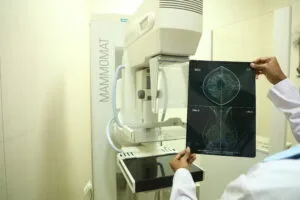Types and Importance of Cancer Screening

Cancer screening implies checking for cancer in asymptomatic people. Screening can help find several types of cancers early, before they manifest clinically. Early detection is important because it allows early treatment and offers greater chances of recovery and even cure. By the time symptoms appear, the cancer may have begun to metastasize and be harder to treat.
But it is important to keep in mind that, screening tests have both pros and cons:
– Overdiagnosis: The screening test correctly shows that a person has cancer, but it might not clearly indicate that the cancer is slow-growing and would not have harmed that person in his or her lifetime, leading to unnecessary treatment.
– False-positives: The test indicates that cancer may be present even though it is not. False-positive test results can cause anxiety and are usually followed by additional tests and procedures that also have potential side-effects.
– False-negatives: The test fails to detect the presence of cancer. False-negative test results may lead to a false sense of security, leading to delays in diagnosis and possibly causing an individual to put off seeking medical care even if symptoms develop.
TYPES OF CANCER SCREENING TESTS:
Not all cancers currently have screening tests, but those that do have specific tests.
Breast Cancer:
– Mammography
– Clinical breast examination
– Breast self-examination
WHO Recommends –
| Age group | Screening |
| <40 years | Not recommended |
| 40 – 49 years | Only as part of organized population-based screening programs |
| 50 – 69 years | Mammogram: Every 2 years |
| 70 – 75 years | Only as part of organized population-based screening programs |
The U.S. Preventive Services Task Force (USPSTF) recommends that women ages 50 to 74 have mammography every 2 years. They recommend that mammography be considered in women ages 40 to 49 after evaluating the risk and benefits of this test with a doctor.
Cervical Cancer:
– Pap smear examination – Conventional or the recommended Liquid Based Cytology (LBC) testing
– Human papillomavirus (HPV) testing
Visual inspection with acetic acid (VIA) is a screening test that can be done with few tools and the naked eye. This screening test is very useful in places where access to medical care is limited.
The ACS/ASCCP Cervical Cancer Screening Recommendations 2020 –
| Age/Condition | Screening |
| <25 years | No screening |
| 25 – 65 years | Starting at age 25, primary HPV test ALONE every 5 years (PREFERRED), or co-testing every 5 years, or Cytology alone every 3 years |
| >65 years | Discontinue if adequate negative prior screening. Individual >65 years without adequate negative history should continue screening till conditions of cessation are met. |
| After hysterectomy | Individuals without a cervix and without a history of CIN2 or a more severe diagnosis in the past 25 years or cervical cancer ever should not be screened |
| HPV vaccinated | Follow age – specific screening recommendations (same as unvaccinated individuals) |
*Adequate negative prior screening (condition of cessation) is currently defined as 2 consecutive, negative primary HPV tests, or 2 negative co-tests, or 3 negative cytology tests within the past 10 years, with the most recent test occurring within the past 3 – 5 years.
Colorectal cancer:
Five types of tests are used to screen for colorectal cancer (CRC):
– Faecal occult blood test (guaiac faecal occult blood / faecal immunochemical test)
– Sigmoidoscopy
– Colonoscopy
– Virtual colonoscopy (CT colonography)
– Stool DNA test
Studies have shown that screening for colorectal cancer using digital rectal exam does not decrease the number of deaths from the disease.
American Cancer Society recommendations for Colorectal Cancer Screening –
| Average Risk | Age/Condition | Screening |
They DO NOT have:
| <45 years | No screening |
| 45 – 75 years | Screen with:
| |
| 76 – 85 years | Decision to be screened should be based on a person’s preference, life expectancy, overall health, and prior screening history. | |
| >85 years | No screening |
The American Cancer Society does not provide recommendations for high-risk individuals. But the same has been offered by the US Multi-Society Task-Force for Colorectal Cancer-
| Personal or family history | Recommendations |
| Persons with 1 first-degree relative with CRC or a documented advanced adenoma diagnosed at age <60 years or with 2 first-degree relatives with CRC and/or documented advanced adenomas | Colonoscopy every 5 years beginning 10 years younger than the age at which the youngest first-degree relative was diagnosed or age 40, whichever is earlier. |
| Persons with 1 first-degree relative diagnosed with CRC or a documented advanced adenoma at age >60 years | Begin screening at age 40. Same screening intervals as average risk people. |
| Persons with 1 or more first-degree relatives with a documented advanced serrated lesion (SSP or traditional serrated adenoma >10 min in size or an SSP with cytologic dysplasia) | Colonoscopy every 5 years beginning 10 years younger than the age at which the youngest first-degree relative was diagnosed or age 40, whichever is earlier. |
Prostate Cancer:
- Digital rectal examination (DRE)
- Prostate-specific antigen (PSA) test
A prostate cancer gene 3 (PCA3) RNA test may be used for certain patients. The PCA 3 gene assay was approved by the U.S. Food and Drug Administration in early 2021, with the intended use to aid in the decision for repeat biopsy in men with a previously negative biopsy for an elevated PSA and for whom a repeat biopsy is being considered for a persistently elevated PSA. This test is performed on a urine sample collected after an attentive digital rectal examination(DRE) – several strokes applied firmly to the prostate to the right and left prostatic lobes. Using a threshold value of 60, this test enhances the detection of prostate cancer while reducing the number of biopsies in men who are expected to ultimately have a negative biopsy.
According to the USPSTF, for men aged 55 to 69 years, the decision to undergo periodic prostate-specific antigen (PSA) – based screening for prostate cancer should be an individual one. It also recommends against PSA-based screening for prostate cancer in men 70 years and older.
The Memorial Sloan Kettering prostate cancer screening guidelines state that men aged 45-70 should have their PSA levels checked. Testing for men between 71-75 years of age should be based on past PSA levels and the health of the man. These guidelines do not recommend testing for men ages 76 or older.
Lung Cancer:
Low-dose computed tomography (LDCT)
The USPSTF recommends annual screening for lung cancer with low-dose computed tomography (LDCT) in adults aged 55 to 80 years who have a 30 pack-year smoking history and currently smoke or have quit within the past 15 years. Screening should be discontinued once a person has not smoked for 15 years or develops a health problem that substantially limits life expectancy or the ability or willingness to have curative lung surgery.
In 2021, the American College of Chest Physicians, the American Society of Clinical Oncology, and the American Thoracic Society recommended screening for lung cancer with LDCT, for persons aged 55 to 74 years who have a ≥30 pack-year smoking history and currently smoke or have quit in the past 15 years.
The American Association for Thoracic Surgery recommends annual screening with LDCT in current and former smokers aged 55 to 79 years who have a 30 pack-year smoking history. It also recommends annual screening starting at age 50- to 70 years in patients who have a 20 pack-year smoking history and additional comorbid conditions that produce a cumulative risk for cancer of at least 5% over the next 5 years. Furthermore, it recommends annual screening in long-term cancer survivors aged 55 to 79 years.
In 2013, the American Cancer Society also began recommending screening for lung cancer with LDCT in high-risk patients who are in relatively good health and meet the following criteria – persons aged 66 to 74 years who have a ≥30 pack-year smoking history and currently smoke or have quit in the past 15 years.
#unburdenhealthcare with us
References:
- Cancer Screening [Internet]. Cancer.Net. 2012 [cited 2020 Feb 2]. Available from: https://www.cancer.net/navigating-cancer-care/prevention-and-healthy-living/cancer-screening
- Screening for Cancer [Internet]. National Cancer Institute. 2015 [cited 2020 Feb 2]. Available from: https://www.cancer.gov/about-cancer/screening
- World Health Organization (WHO). WHO position paper on Mammography Screening [Internet]. 2014 [cited 2021 Feb 2].Available from: https://www.who.int/cancer/publications/mammography_screening/en/
- Final Recommendation Statement: Breast Cancer: Screening – US Preventive Services Task Force [Internet]. [cited 2020 Feb 2].Available from: https://www.uspreventiveservicestaskforce.org/Page/Document/RecommendationStatementFinal/breast-cancer-screening1
- Cervical Cancer – Screening and Prevention [Internet]. Cancer.Net. 2012 [cited 2020 Feb 2]. Available from:
https://www.cancer.net/cancer-types/cervical-cancer/screening-and-prevention
- Fontham ETH, Wolf AMD, Church TR, Etzioni R, Flowers CR, Herzig A, et al. Cervical cancer screening for individuals at average
risk: 2020 guideline update from the American Cancer Society. CA Cancer J Clin. 2020 Sep;70(5):321-46.
- Colorectal Cancer Screening (PDQ®)-Patient Version [Internet]. National Cancer Institute. 2019 [cited 2020 Feb 2]. Available from:
https://www.cancer.gov/types/colorectal/patient/colorectal-screening-pdq
- Wolf AMD, Fontham ETH, Church TR, Flowers CR, Guerra CE, LaMonte SJ, et al. Colorectal cancer screening for average-risk adults: 2018 guideline update from the American Cancer Society: ACS Colorectal Cancer Screening Guideline. CA Cancer J Clin.2018 Jul;68(4):250-81.
- Rex DK, Boland CR, Dominitz JA, Giardiello FM, Johnson DA, Kaltenbach T, et al. Colorectal cancer screening: Recommendations for physicians and patients from the U.S. Multi-Society Task Force on Colorectal Cancer. Gastrointest Endosc. 2017 Jul;86(1):18-33.
- Prostate Cancer Screening (PDQ@®)}Health Professional Version [Internet]. National Cancer Institute. 2019 [cited 2020 Feb 2].
Available from: https://www.cancer.gov/types/prostate/hp/prostate-screening-pdq
- Final Update Summary: Prostate Cancer: Screening – US Preventive Services Task Force [Internet]. [cited 2020 Feb 2]. Available from: https://www.uspreventiveservicestaskforce.org/Page/Document/UpdateSummaryFinal/prostate-cancer-screening1
- Prostate Cancer Screening Guidelines | Memorial Sloan Kettering Cancer Center [Internet]. [cited 2020 Feb 2]. Available from:
https://www.mskcc.org/cancer-care/types/prostate/screening/screening-guidelines-prostate
- Final Recommendation Statement: Lung Cancer: Screening – US Preventive Services Task Force [Internet]. [cited 2020 Feb 2].
Available from: https://www.uspreventiveservicestaskforce.org/Page/Document/RecommendationStatementFinal/lung-cancer-screening
- Bach PB, Mirkin JN, Oliver TK, Azzoli CG, Berry DA, Brawley OW, et al. Benefits and Harms of CT Screening for Lung Cancer: A Systematic Review. JAMA. 2012 Jun 13;307(22):2418.
- Jaklitsch MT, Jacobson FL, Austin JHM, Field JK, Jett JR, Keshavjee S, et al. The American Association for Thoracic Surgery guidelines for lung cancer screening using low-dose computed tomography scans for lung cancer survivors and other high-risk groups. J Thorac Cardiovasc Surg. 2012 Jul;144(1):33-8.
- Wender R, Fontham ETH, Barrera E, Colditz GA, Church TR, Ettinger DS, et al. American Cancer Society lung cancer screening guidelines: American Cancer Society Lung Cancer Screening Guidelines. CA Cancer J Clin. 2013 Mar;63(2):106-17.



